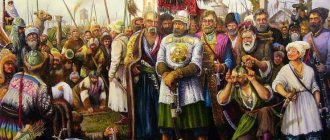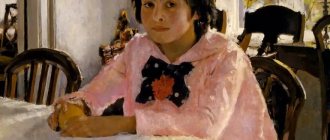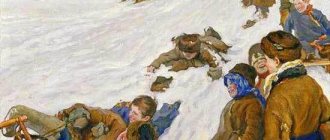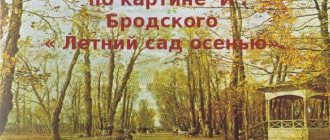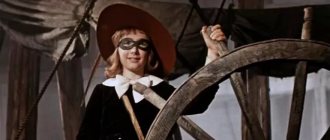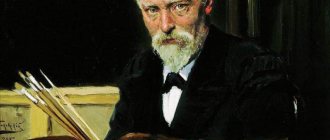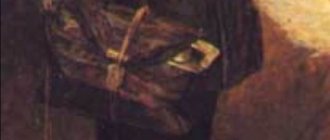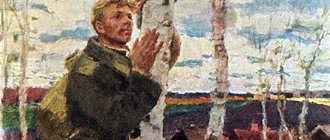- Essays
- According to paintings
- Surikov
- Taking the snow town
“The Capture of a Snowy Town” is one of the most positive paintings by V.I. Surikov.
The canvas depicts many people who came to watch the battle. To win, you need to capture the snowy town that was built in advance. The snow fortress was built in a deserted place, with no houses visible. Gentle hillsides covered with white snow are visible. The sky merges with the hills, it is as light as snow.
In the foreground of the picture is a horseman breaking a wall of snow. The horse's powerful hooves have broken through the wall, and small lumps of snow are flying in different directions. The horse is dark brown in color and has a black mane. The rider on the horse leans slightly forward, with one hand he holds the horse's bridle, and with the other he waves it, encouraging it. The rider is dressed in a brown camisole and a brown fur hat. The rider's face is tense and turned to the side.
Almost under the horse’s hooves stands a boy in a red sheepskin coat, belted with a sash. He leaned heavily to the side, hiding from the lumps of snow. His hat fell off his head. The boy has blond, curly hair.
A crowd follows the rider on the horse. They scream and wave their arms with branches and sticks. They have excited, joyful faces. The guy in the light sheepskin coat trimmed with black fur especially stands out. The short fur coat is belted with a red belt. The guy has a gray hat on his head. The right hand with a large branch is raised up, the left hand is lowered down.
On the right, the picture shows a sleigh. Two women are sitting on a sleigh. They came to watch the capture of the snowy town. The sleigh is covered with a beautiful carpet painted with bright flowers. An elderly woman leaned forward and watched with interest what was happening. She is wearing a brown fur coat and a light scarf, and her mittens are also fur. Nearby, most likely, is a young girl in a black fur coat with a white collar. A braid with a red bow is attached to the collar. On his head is a blue cap trimmed with gray fur. The girl turns away from the rider because snow is flying at her from under the horse’s hooves.
Below, in the left corner of the picture, a small part of the sleigh is visible. Peasant sleighs, they are covered with straw. A man in a light sheepskin coat is sitting in a sleigh. He waves to the rider on the horse.
Essay on the painting The Capture of the Snowy Town of Surikov
The canvas depicts many people who came to watch the battle.
To win, you need to capture the snowy town that was built in advance. The snow fortress was built in a deserted place, with no houses visible. Gentle hillsides covered with white snow are visible. The sky merges with the hills, it is as light as snow. In the foreground of the picture is a horseman breaking a wall of snow. The horse's powerful hooves have broken through the wall, and small lumps of snow are flying in different directions. The horse is dark brown in color and has a black mane. The rider on the horse leans slightly forward, with one hand he holds the horse's bridle, and with the other he waves it, encouraging it. The rider is dressed in a brown camisole and a brown fur hat. The rider's face is tense and turned to the side.
Almost under the horse’s hooves stands a boy in a red sheepskin coat, belted with a sash. He leaned heavily to the side, hiding from the lumps of snow. His hat fell off his head. The boy has blond, curly hair.
A crowd follows the rider on the horse. They scream and wave their arms with branches and sticks. They have excited, joyful faces. The guy in the light sheepskin coat trimmed with black fur especially stands out. The short fur coat is belted with a red belt. The guy has a gray hat on his head. The right hand with a large branch is raised up, the left hand is lowered down.
On the right, the picture shows a sleigh. Two women are sitting on a sleigh. They came to watch the capture of the snowy town. The sleigh is covered with a beautiful carpet painted with bright flowers. An elderly woman leaned forward and watched with interest what was happening. She is wearing a brown fur coat and a light scarf, and her mittens are also fur. Nearby, most likely, is a young girl in a black fur coat with a white collar. A braid with a red bow is attached to the collar. On his head is a blue cap trimmed with gray fur. The girl turns away from the rider because snow is flying at her from under the horse’s hooves.
Below, in the left corner of the picture, a small part of the sleigh is visible. Peasant sleighs, they are covered with straw. A man in a light sheepskin coat is sitting in a sleigh. He waves to the rider on the horse.
Essay-description based on the painting “The Capture of the Snowy Town”, Vasily Surikov
Author: Nikita, 4th grade
Thanks to the painting “The Capture of a Snowy Town,” I learned that the tradition of playing an attack on a fortress appeared a long time ago. I see a horseman who has broken through the defenders and has already broken the wall. From the destroyed fortress, lumps of snow and ice fly in different directions.
His comrades support him with joyful cries and smiles. The defenders are annoyed that they lost so quickly. In addition to the players, there are also ordinary spectators. They came to watch the entertainment, because there was not much entertainment in the village in winter.
Author: Lada, 4th grade
Winter is my favorite time of year. It was interesting to learn about the old tradition of playing the game of capturing a snow fortress, which is depicted in the painting by V.I. Surikov. The artist himself was born in the village, so in his youth he also took part in such fun or watched them.
He depicted a whole crowd that had gathered to play or look at others. It is difficult to figure out who is the attacker and who is the defender, because the main action has already ended. A young man on horseback broke through the defenses and destroyed the fortress. The picture was educational for me.
Author: Vitaly, 8th grade
Painting by V.I. Surikov is dedicated to folk fun in Rus', when on the last day of Maslenitsa villagers gathered to play at taking a fortress. Particular attention is drawn to a man on a horse, who gallops through the wall of a fortress made of snow and ice. People around him are surprised by such a sharp turn in the game, because with his actions he ended it in an instant. Some smile with joy at their victory, while others are disappointed by the quick defeat. There are so many emotions on people's faces that there is not one similar. Everything is drawn in very detail, so you just want to peer into the canvas. Acquaintances posed for Surikov, so the faces turned out so lively and interesting.
There are many details in the picture that indicate that Surikov painted it carefully and with love. Clothes, some decoration of the fortress in the form of an animal’s head – everything is very clearly and vividly depicted. I like canvases where you want to admire the details, and not just the central plot. I saw the smile on the face of the young man in the background, the patterns on the man’s felt boots, the flakes of snow and particles of ice into which the fortress had crumbled.
It's nice to see that the artist put his soul into the image and put effort into his work. In the case of V.I. Surikov, the reason for this could be the death of his beloved wife Lisa, after which he and his children moved back to their small homeland. Creativity helped him return to normal life, which is why he devoted so much time and attention to it.
In my opinion, the picture perfectly demonstrates that moment of joy, enthusiasm and enjoyment of life that the people depicted experienced. This mood involuntarily passed on to me, so I peered with interest at the details and color schemes of the artist. I think this is a painting by V.I. Surikov deserves the popularity it enjoys.
Essay-description of Surikov’s painting The Capture of a Snowy Town
One of the kindest and lightest paintings by Vasily Surikov was painted in his hometown of Krasnoyarsk and presented in 1891, which immediately gained worldwide fame. It was written after a difficult period for the artist, when he lost a loved one and his wife died, returning to him his former passion for creativity and enlightenment. This picture is imbued with cheerful Siberian energy and fun, which makes us smile, because the soul of a Russian person always requires noise and mood.
The picture is based on Russian fun, that is, festivities at Maslenitsa, which are usually celebrated friendly and on a grand scale. On this day we say goodbye to winter and welcome the beautiful spring. Everything is dynamic and full of movement. We see an assault on a snow fortress made of ice and snow, which apparently took several days to prepare.
The picture captures the play of men in a very interesting way. Divided into 2 teams, one of which defends, the others try to capture and destroy this snowy town. As a result, the town was destroyed and everyone burst into loud laughter and joy. The whole crowd of people in bright and beautiful outfits. They are joyful, cheerful and carefree. But it’s worth noting, taking a closer look at each of the characters, that they are all endowed with different emotions and facial expressions. All faces are rosy, but each has their own feelings, thoughts and even poses. All characters have individuality.
8th grade essay based on Surikov’s painting “The Capture of the Snow Town”
Author: Ruslan, 8th grade
In Rus', children and youth had a lot of winter fun. One of these is the capture of a snow fortress or town, which is depicted in the painting by V.I. Surikov with the same name. This work was written during a difficult period for the artist. After the death of his beloved wife, he was in deep depression, from which immersion in creativity helped him get out of it. Surikov had seen such winter fun in his childhood, so he was very familiar with them. Real people posed for him for this painting, including his friends. The artist began painting it in his small homeland, and finished it a few years later in Moscow.
The canvas is a complete image, made according to the rules of theatrical composition, when the ongoing plot can be divided into central and side parts. In the center of the picture we see a young guy on a horse, who rushes on it through the wall of a snow fortress, thereby destroying it. The main attention is paid to him, because after his maneuver the town is taken, the game ends. Behind him were other guys with branches in their hands. These are both the defenders of the fortress and its attackers. Some look joyfully at the man on the horse, while others are annoyed by the defeat. Spectators stand on the sides, they do not have branches or other weapons of defense, they watch the game with interest.
The artist manages to immerse you in what is happening in the picture. I just want to look at people’s faces, their movements, and guess what they are thinking and would like to do. I think the reason for this is the variety of emotions that people’s faces are full of. Each character is part of an integral composition that Surikov managed to create.
The mood of the canvas is joyful. It perfectly illustrates the fighting spirit and active winter fun of young people in the villages. I was interested to learn about such a traditional Russian game through this picture.
Popular topics today
Studying the composition of Shishkin’s canvas Oak Grove, perennial, spreading, mighty oak trees appear before my eyes. I like their pristine beauty. Many people walked along them
This is such a bright, summery, pleasant picture! I like her very much. You immediately feel like you are somewhere in the summer and in the country. The artist conveyed exactly that wonderful state when you take a break from the heat in a room like this - in the cool.
This is a very interesting picture. Nowadays such a thing as a “bathroom” looks strange. This happened in the past, but now, probably, it remains only in Muslim countries, where people already swim dressed.
The creativity of Fyodor Pavlovich Reshetnikov is multifaceted and original. He was one of the most famous satirists, a master of caricatures and the creator of wonderful sculptures of a humorous nature.
Vasnetsov’s painting “The Knight at the Crossroads” depicts a strong Russian horseman on a mighty white horse, who stopped in front of a huge gray stone lying at the crossroads, with an inscription carved on it.
Source
Description essay: Taking a snowy town based on Surikov’s painting (3, 6, 8 grades)
Vasily Ivanovich Surikov was from Siberia, from Krasnoyarsk. And he could well observe a similar picture. Winter lasts a long time there. But it also ends. Maslenitsa is coming - people celebrate the arrival of spring with nursery rhymes and fun. What else can people do if not have fun? One of these popular folk pastimes is the capture of a snowy town.
There is a lot of snow, it is sticky and an excellent building material. The meaning of this folk game is that one opposing side builds a snowy town, and the other takes it by storm. And both sides are happy and cheerful.
Outside the village, a snow fortress is being built. The houses are nowhere to be seen. There is no forest visible, only in the distance the gentle slopes of the mountains, covered with forest in the summer. Now these slopes are covered with snow, it merges with the sky. Grown people fool around like children. They are seriously storming the bastions of the snowy town.
In the foreground of the picture, a decently dressed man, with an expensive fur hat on his head, is tearing down a snowy wall on a galloping horse. Under the hooves of a powerful stallion, snow flies in all directions. The man holds the horse by the reins with a powerful grip of his left hand, and waves his right hand invitingly in the air. His face is turned to the right, he looks at the audience.
He almost knocked over the boy, who jumped to the side in time, his hat falling off his head. Unlike the rider, the boy is poorly dressed - in a zipun belted with a rope. A man on a horse is followed by a variegated foot guard with branches in their hands. They also fool around from the heart. One of the “warriors” has a smile on his face. He is dressed in a white sheepskin coat, belted with a red belt. Therefore, it is impossible not to notice it.
On the right in the picture is a sleigh. This is clearly a rich people's sled. They are covered with a rich colored carpet. There are two women sitting in a sleigh and a man opposite them. They have rich clothes - fur coats, hats, mittens. However, it is clear that the woman is watching what is happening with attention. She leaned forward.
But the girl in a beautiful expensive fur coat with a white collar and a neat blue cap, on the contrary, moves away from the screaming crowd. It's unpleasant for her.
On the left side of the picture is the sleigh of a common man. Instead of a rich carpet, the interior is lined with straw. The man himself is dressed, it’s hard to tell what he’s wearing. He waves his hand at the rider invitingly, riding away from the rushing horse.
Surikov wrote down each character individually. Not a gray faceless mass, but people so different in social status. But this snow battle leveled everyone. Everyone is tired of the long, cold Siberian winter, everyone wants sun and warmth. I want to take part in it myself and join the laughing crowd.
Surikov's painting taking a snowy town description story
Do you like to draw or dream of becoming an artist? Or maybe you are just interested in painting? Then you should look more often at paintings by outstanding masters of the brush.
Vasily Ivanovich Surikov, “The Capture of the Snowy Town,” 1891. Oil on canvas. 156 × 282 cm. State Russian Museum, St. Petersburg
In this article we will talk about the painting “The Capture of the Snow Town” by Vasily Ivanovich Surikov. The canvas was painted in 1891 and exhibited at the State Russian Museum (St. Petersburg).
The picture was painted in the everyday genre and in the style of impressionism. Many of the artist’s relatives and friends served as sitters.
The canvas depicts the inhabitants of Siberia during an ancient folk game on the last day of Maslenitsa. The author managed to convey the full scope and fun of folk festivities.
Pay attention to the faces; each participant in the events has his own character. People are bursting with health, freshness and enthusiasm.
The detail of the drawing is amazing. The artist managed to masterfully convey a bright moment of the festive life of Siberians.
This work can be called the most cheerful among the works of Vasily Surikov.
Essay-description of 8th grade on the painting “The Capture of the Snowy Town”
Author: Aida, 8th grade
It is common for creative people to convey feelings through their works. Thus, the painting “The Capture of the Snowy Town” conveys both joyful and sad feelings. It was written in a difficult way for V.I. Surikov’s period when he was grieving the death of his beloved wife, trying to distract himself with something positive. This is exactly what is felt in the canvas. It seems to be imbued with enthusiasm and fun that emanates from the people depicted on it. As the basis for the plot, Surikov took the ancient Russian fun of Maslenitsa, when young men were divided into two groups, one of which built and guarded the fortress, and the other attacked it.
The painting shows a lot of details and faces. At first glance, your eyes run wide: you don’t know what to pay attention to. Taking a closer look, I identified three groups of people: spectators, defenders and attackers. They stand with their faces and backs to the viewer, which creates a certain chaos in the image, as if you are becoming part of this game, when everyone is running and fussing. The picture gives a feeling of immersion in what is happening. I paid special attention to the young man on horseback, who destroyed the snow fortress, thereby ending the game. His teammates stand next to him with branches in their hands, some with their mouths slightly open, joyfully watching their victory. Others look slightly dazed. Perhaps they did not expect such a sharp attack from a man on a horse.
The artist perfectly managed to convey a wonderful frosty day. The light blue sky, mountains of snow, warm sheepskin coats and hats, as well as the faces of the participants flushed from the frost and active play add vividness to the image. Looking at this, I feel like I am part of this winter fun.
Although this game and its significance for residents of Rus' before the painting by V.I. I was not familiar with Surikova, I can say that the tradition of building a snow fortification and playing to conquer it has been preserved to this day. I think this picture is interesting not only from a visual, but also from a historical point of view for those who are interested in the traditions and customs of the Russian people.
V. Surikov. Taking the snow town
Vasily Surikov. Capture of the snow town. 1891. Russian Museum, St. Petersburg.
Depression in its most severe form overwhelmed the master. And then the love of daughters came to the rescue. They helped him endure the loss as best they could, and who knows, maybe it was this love for his father that brought him back to life, and, consequently, to painting. And he returned and returned triumphantly.
Trying to distract Surikov from difficult thoughts after the loss of his beloved wife, brother Alexander gave him the idea of writing an old Maslenitsa Cossack fun - an assault on a fortress built from snow. The artist became interested, began collecting material with pleasure, looking for details and images. Every market day, from early morning, he went to where the people were gathering, and with lively interest peered into the faces of Krasnoyarsk residents, figured out how organically each type would look in the picture, decided what kind of light to use: diffused - to convey a cloudy day, or the bright winter sun .
The master sketched paintings above the arches on ancient koshevas, rich patterns of Tyumen carpets and any unusual details of sleighs and sledges. But most of all, Surikov was occupied with the images necessary for the crowd of spectators. He didn’t have to look particularly hard, he just had to step out of the gate - everyone he met had the characteristic features of Siberian masculinity, and it seemed to him that any of these faces fit perfectly into the picture, everyone was close and understandable with their Siberian harsh beauty.
Alexander Ivanovich actively participated in the creation of the picture, helped his brother, took him around the villages without fail, and even organized the “taking of the town” itself. In the estate they built a special fortress made of ice and snow with towers and battlements, and also found a Cossack who “stormed” it on a dashing black stallion. The painter painted easily as never before, so the painting “The Capture of the Snowy Town” turned out to be joyful and playful.
Surikov, who had Cossack roots in his family, was close to local customs and the fun of festive festivities. The composition of the picture is dynamic, full of movement, the viewer seems to be involved in the general action, feels the frosty air and snow flying around.
“I wrote what I myself have seen many times. I wanted to convey in the picture the impression of a unique Siberian life, the colors of its winter, the prowess of Cossack youth,” said Vasily Ivanovich. In this work there are many of his Krasnoyarsk acquaintances and even his brother Alexander, depicted in a hat with earflaps in a sleigh covered with a Tyumen carpet.
“The Capture of the Snow Town” was exhibited in St. Petersburg in 1891 and surprised the public by its inconsistency with the artist’s usual tragic role. Like, that’s not what we expected from Surikov, we, they say, expected something amazing and historical from him again. And no one then understood that in this painting there was precisely a hymn to Russian expanse, a hymn to Russian incontinence. Critics appreciated this painting much later, and the public even later. The bright, positive and life-affirming work was not bought for a long time; only a few years later it was sold to the collector Vladimir von Meck for ten thousand rubles.
And nine years later, at an international exhibition in Paris, Surikov received a personalized medal for the painting “The Capture of a Snowy Town.”
Source
An essay based on a painting by V.I. Surikov “The Capture of the Snow Town”
Vasily Ivanovich Surikov is a great Russian painter recognized during his lifetime, who painted historical subjects and portraits.
Surik’s most significant masterpieces are recognized as seven paintings, including a painting called “The Capture of a Snowy Town.”
The three paintings that were first written are in the Tretyakov Gallery in Moscow, the other four are in St. Petersburg, in the Russian Museum.
The painting “The Capture of the Snowy Town” is also among the permanent exhibition of the Russian Museum. What is the capture of a snowy town and why is this picture called that?
This is a folk game, most beloved in Siberia and the Urals. On the eve of Maslenitsa, a town was built on a field of snow, they played throughout Maslenitsa week, and on the last day of the holiday, Forgiveness Sunday, the town was destroyed to the ground. The capture of the snowy town, like the entire Maslenitsa holiday, symbolized the change of seasons, the onset of spring after a harsh winter. The rules of the game are simple: the players were divided into two teams - attackers and guards. The goal of the attackers is to break into the town and conquer it. The task of the guards is to prevent them from doing this. On the last day of the game, the attackers had to not only conquer the town, but also capture the straw effigy of Maslenitsa and burn it.
Little Vasya Surikov saw this game for the first time when he was taken to his mother’s native village, which was called Torgoshino. She sunk into his soul with her fun, joy, and bright colors. It was only later that Surikov’s younger brother Sasha gave him the idea of painting a picture on the theme of this holiday.
Vasily Ivanovich Surikov was a truly great artist, obsessed with his profession, and the main feature of his nature was, undoubtedly, his love for the Russian people. It is also surprising that he began to paint this, the brightest and most cheerful of his paintings, during the most difficult period of his life: the artist was very worried about the death of his beloved wife. What do we see in the picture? A bright positive picture, full of joy, fun and triumph of strength and health, splashing over the edge! Apparently our people have a lot of such health!
It’s amazing how carefully each person in the picture is painted – boys, girls, women. Their faces simply glow with joy! Objects are also depicted with subtle details and love - a bright carpet in a sleigh, a fur collar, peasant clothes. Beautiful, cheerful, healthy and strong Russian people during a holiday and a daring game - that’s what “Taking the Snow Town” is all about.
Surikov painted all his canvases using nature - both objects and people. In this picture he also depicted his brother Alexander - he is on the right in the picture. Nearby is the wife of the Krasnoyarsk doctor Ekaterina Aleksandrovna Rachkovskaya. The town itself was built on the estate of the Surikovs themselves. And the peasants of the village of Bazaikha became the remaining characters.
The painting was completed in 1891, and already in 1900, at an international exhibition in Paris, it received a personalized medal.
If you find an error, please select a piece of text and press Ctrl+Enter.
All works based on paintings by V.I. Surikov.
Share with friends:
We also recommend watching!
An essay based on a painting by I.A. Popov "First Snow"
An essay based on a painting by V.A. Tropinina "The Lacemaker"
An essay based on a painting by S.A. Grigoriev "Goalkeeper"
An essay based on a painting by V.G. Perov "Hunters at Rest"
An essay based on a painting by V.M. Vasnetsov “The Frog Princess”
Essay based on the painting by I.I. Levitan "At the whirlpool"
An essay based on a painting by K.F. Yuona “Spring Sunny Day”
Essay based on the painting by I.K. Aivazovsky “Feodosia. Moonlight night"
An essay based on a painting by K.F. Yuona "March Sun"
Essay based on the painting by I.I. Levitan "Above Eternal Peace"
Essay based on the painting by I.I. Levitan "Quiet Abode"
An essay based on the painting by Isaac Levitan “Spring. Big water"
Painting The Capture of a Snowy Town, Surikov Vasily 1891
The capture of the snow town was usually celebrated on the sixth day of Maslenitsa. As a rule, a group of peasants consisting of strong peasants built snow towns with gates and towers in the fields, on rivers in the vicinity of villages, then the composition of the peasants was divided into defenders and attackers who only wanted to take the built town by force, that is, destroy it.
The defenders of the town, according to the custom of the ritual, defended themselves with shovels and brooms. When the attackers attacked, the defenders used shovels to try to cover the attackers with snow, waved and hit them with branches and brooms, shot upwards from guns, trying to scare off the horses and not let anyone through the gate; if anyone broke through the defense of the strong guys, they were considered the winner of the game. Often such games ended with injuries to the peasants, nevertheless, these events brought the people a feeling of joy and fun.
Essay example
Before us is the painting “The Capture of a Snowy Town” by artist Vasily Surikov. The canvas depicts one of the days of Maslenitsa. According to tradition, men built towns with gates and towers out of snow in the vicinity of the village. Then the peasants were divided into defenders and attackers who wanted to destroy the town, and the game began. The action takes place in a snow-covered expanse. In the center of the picture is a rider on a horse, destroying a snowy town. Lumps of snow fly away from him in different directions. There are a lot of people around. People from the defense team cheerfully wave their branches to ward off attackers. One man was so captivated by the game that his hat even fell off. Some peasants have already joyfully thrown down their branches, because the town is destroyed and the game is over. In the painting, the artist depicted all classes of the people. On the right, the painting shows a cart covered with a bright cape. Richly dressed women are sitting in it; they also came for the holiday and watch how the horseman destroys the snow walls of the town. On the left are men in fur clothes, with fur hats on their heads. They wave their arms and cheer for their team. A little further away, smartly dressed women and children stand. All the people rejoice at the holiday. In the distance you can see hills and vast Russian expanses. When I look at this painting, I also feel a joyful, festive mood, because the artist managed to convey the holiday atmosphere very well in his painting.
Vasily Surikov. Taking the snow town
Vasily Surikov. Taking the snow town
The painting “The Capture of a Snowy Town” was painted in 1891, oil on canvas, 156 by 282 cm. Currently, the painting is in the collection of the State Russian Museum in St. Petersburg. The canvas clearly depicts a traditional game that has deep roots and appeared, in all likelihood, in the pre-Christian era - pagan times in Rus'. It is worth noting that the game still exists and is held on Maslenitsa in different regions of Russia, where ancient traditions are loved and honored.
Surikov’s painting depicts the moment of the immediate capture of the town. A participant in the game from a group of attackers on horseback breaks through the defense of the town and destroys the snow barrier.
The picture shows how a large number of people have gathered around, watching with smiles and joy on their faces how the snow fortress will fall this time. Surikov also showed that the traditional game is interesting for both children and adults. Moreover, representatives of different classes watch the game. On the left side of the picture there are ordinary peasants who are sincerely enjoying the fascinating spectacle.
In the background, behind the horse destroying the fortress, there are players from a group of defenders, they wave branches to scare away the horses.
On the right side of the picture, Surikov depicted a richly dressed noble couple who are watching the capture of the snowy town with no less passion and enthusiasm.
In order to make the picture as realistic and authentic as possible, Surikov was helped by Siberian peasants, who built a snowy town especially for the artist and posed for the painter. After painting the picture, Vasily Surikov presented it in St. Petersburg. After some time, it was bought by the philanthropist and collector Vladimir von Meck. At an exhibition in Paris, Surikov was awarded a personalized medal for his painting “The Capture of a Snowy Town.”
Vasily Ivanovich Surikov (January 12 (24), 1848, Krasnoyarsk - March 6 (19), 1916, Moscow) - Russian painter, master of large-scale historical canvases.
Source
Essay based on the painting by V. Surikov “Menshikov in Berezovo”
Among other historical paintings by Vasily Surikov, “Menshikov in Berezovo” occupies a special place. On it the artist did not depict battles or campaigns, but in the figures and faces of several inactive heroes he was able to depict an entire era. Surikov showed us the family of Alexander Menshikov, a famous Russian statesman from the time of Peter I. This man was not only the favorite and friend of the king - a lot of power and a lot of money were concentrated in his hands. After the death of Peter, Menshikov continued to exert enormous influence on state policy. His plans were ambitious; he even planned to marry off his eldest daughter as the heir to the throne. But history decreed otherwise. Menshikov fell out of favor. His wealth was confiscated, and he and his family were sent into exile. Menshikov's wife dies on the road. Exiled life is strikingly different from the one to which the Menshikovs are accustomed in the capital. They don’t even have servants in the house, and the children of the recent favorite did all the work themselves. Surikov showed the moment when the Menshikovs gathered at the table in their new home. The faces of the characters in the picture show sadness and thoughtfulness. Menshikov himself looks like someone whose gaze is turned to the past. One can only guess what he is thinking about. Is he looking for mistakes and miscalculations in his actions, wondering what he should have done so as not to get such an ending? Does he remember and yearn for the times of lost power? It seems unlikely that he was making plans. He looks resigned to his lot. Menshikov seemed to accept defeat and admit it. Menshikov’s eldest daughter and son look confused and sad. They are grieving for a lost life. They are not outstanding figures like their father. They are not ready to challenge fate, to fight for their future. They seemed to have given up too. A certain optimism can only be seen in the face and figure of the youngest daughter. The fate of the sisters was sad - they died very young. But in Surikov’s painting, the blonde girl on the right seems to be full of hope. Life did not stop for her, as for all of Russia. The era has changed and new rulers have come. It won't be the same as before, but it will be different. And all this together will form a single canvas of Russian history. Even the colors in the painting change when you look from left to right. On the left side is the darkest, black corner of the room. Menshikov and his eldest daughter are wearing dark clothes. And on the right, on the younger Menshikova you can see a bright skirt, light fur and sheepskin coat trim. And in the very right corner there are images and a lit candle with its warm reddish light. It seems amazing to me how skillfully Surikov was able to convey this movement from humility to hope. Something similar can be seen in his other paintings. Movement from life to death in “The Morning of the Streltsy Execution”, from fear to determination in “Suvorov’s Crossing of the Alps.” Physical movement (the sliding sledge in “Boyaryna Morozova” and the rapid jump of a horse in “The Capture of the Snow Town”) is transformed into the movement of entire eras, which is shown in the faces of historical characters. Motionless on their own.
Description 2
The story of this painting begins in the city of Krasnoyarsk. It was there that the artist went at the most difficult moment of his life. Vasily Surikov lost his beloved wife and, in order to somehow escape from his grief, he went to his hometown. There he watched fairs and bazaars for many months, looked at the images, clothes, and life of ordinary people and, in the end, painted the painting “The Capture of the Snowy Town.”
This picture immediately attracts attention; it seems that the author who created it is an unusually happy person.
The canvas depicts a day off. Most likely this is a Sunday market.
At first glance you can get confused. There are a lot of people in the foreground. One man on a horse.
If you look closely, it will be clear that this is a kind of village fun.
In the foreground is a rider; you can see from his face that he is very focused. Immediately his path is blocked by people without horses. They are trying to stop the rider and prevent him from breaking through to the snow fortress.
